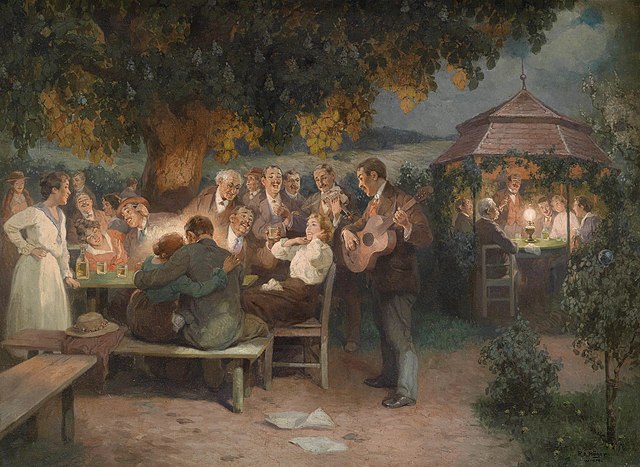Gemütlichkeit is a German-language word used to convey the idea of a state or feeling of warmth, friendliness, and good cheer. Other qualities encompassed by the term include cosiness, peace of mind, and a sense of belonging and well-being springing from social acceptance. The adjective "gemütlich" is translated as "cosy" so "Gemütlichkeit" could be simply translated as "cosiness".
Beim Heurigen in Grinzing is a typical scene of Gemütlichkeit, painting by Rudolf Alfred Höger (1900).
Interior of the Café Hawelka with plush furniture and muted colours, serving cake and coffee, is a typical example of Gemütlichkeit.
A cosy Stube normally has many wooden elements, giving a feeling of warmth and comfort (inside of Schreiberhaus in Neustift am Walde, Vienna).
Hofbräukeller garden in Munich, a typical German beergarden scene, permeated by Gemütlichkeit
The Biedermeier period was an era in Central Europe between 1815 and 1848 during which the middle classes grew in number and the arts began to appeal to their sensibilities. The period began with the end of the Napoleonic Wars in 1815 and ended with the onset of the Revolutions of 1848.
Der Sonntagsspaziergang painting by Carl Spitzweg, a typical representation of the Biedermeier period (1841)
Austrian Biedermeier sofa, c. 1815–1825, mahogany, upholstery (not original), Montreal Museum of Fine Arts (Montreal, Canada)
Emperor Francis I of Austria in his study at the Hofburg palace. The interior is in the Biedermeier style. The Concert of Europe, ensured by the Austrian chancellor and foreign minister Klemens von Metternich, enabled the period of peace in which Biedermeier sensibilities developed.
Biedermeier room in the museum of Chrzanów, Poland








